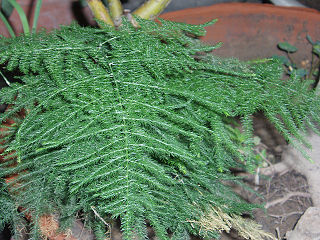
Asparagus is a genus of flowering plants in the family Asparagaceae, subfamily Asparagoideae. It comprises up to 300 species. Most are evergreen long-lived perennial plants growing from the understory as lianas, bushes or climbing plants. The best-known species is the edible Asparagus officinalis, commonly referred to as just asparagus. Some other members of the genus, such as Asparagus densiflorus, are grown as ornamental plants.

Renosterveld is a term used for one of the major plant communities and vegetation types of the Cape Floristic Region which is located in southwestern and southeastern South Africa, in southernmost Africa. It is an ecoregion of the Mediterranean forests, woodlands, and scrub biome.

Anna Amelia Mauve was a South African botanist who worked at the Botanical Research Institute in Pretoria. She catalogued more than 4,000 plant specimens from the Kalahari and Soutpansberg regions. She made major contributions to the journals Flowering Plants of Africa and Bothalia.
Ribes binominatum is a species of currant known by the common names trailing gooseberry and ground gooseberry.
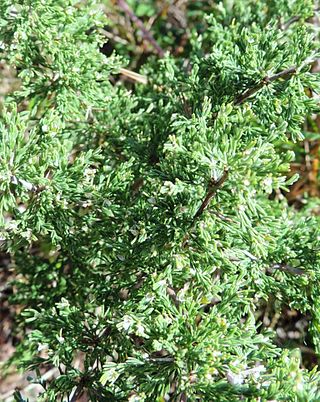
Asparagus capensis, also called katdoring is a dense, thorny, shrub of the Asparagus genus, that is indigenous to South Africa and Namibia.
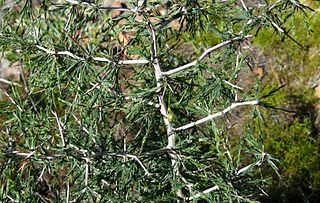
Asparagus lignosus ("Katdoring") is a thorny, spindly creeper of the Asparagus genus, that is indigenous to the Western Cape Province of South Africa.
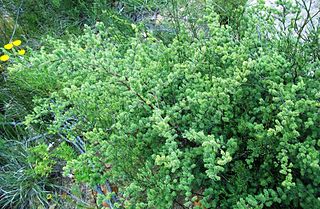
Asparagus rubicundus is a fluffy, thorny shrub of the Asparagus genus, that is endemic to the Cape Provinces of South Africa.

Duvalia elegans is a small succulent plant species, in the family Apocynaceae. It is the type species of the genus Duvalia, and it is endemic to the Western Cape Province, South Africa.

Duvalia caespitosa is a small succulent plant species, in the family Apocynaceae, widespread in South Africa.
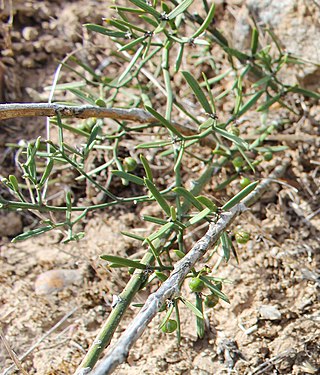
Asparagus striatus ("Bergappel") is a hard perennial shrublet of the Asparagus genus, that is indigenous to dry, rocky areas of South Africa.

Asparagus mucronatus ("Katdoring") is a thorny shrub or creeper of the Asparagus genus, that is indigenous to the southern Cape regions of South Africa.
Asparagus multiflorus is a robust shrub or climber of the Asparagus genus, that is indigenous to the southern Cape regions of South Africa.

Asparagus krebsianus is a shrub of the Asparagus genus that is native to rocky areas in southern Africa. It ranges from central Malawi through Mozambique to the Northern Provinces, KwaZulu-Natal, and Cape Provinces of South Africa.
Asparagus burchellii, is a shrub of the Asparagus genus, that is indigenous to dry scrub vegetion in the southern Cape region, South Africa.

Asparagus retrofractus is a shrub of the Asparagus genus that is indigenous to the western regions of South Africa.
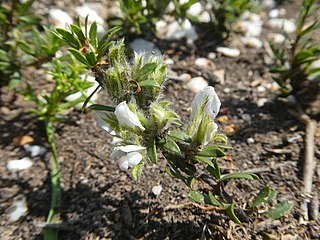
Otholobium curtisiae is a small spreading shrub assigned to the Pea family. All green parts are covered in hairs and urn-like glands. It has many woody stems, small and somewhat succulent, dark green alternately set clover-like leaves and heads consisting of 3-9 white, pea-like flowers on very short peduncles in the axils of the leaves. This species is an endemic of the Overberg area in the Western Cape province of South Africa. It mostly flowers in August and September.

Selago ramosissima is a species of plant in the family Scrophulariaceae. It is endemic to the Western Cape, South Africa.
Selago thomii is a species of plant in the family Scrophulariaceae. It is endemic to the Western Cape, South Africa.
Acrodon parvifolius, the Botriver tiptoothfig, is a species of mesemb from South Africa. This species, which grows close to the ground, can best be recognised by its small, thin leaves and its flowers, which form a dome in the middle.
Acrodon subulatus, the Overberg tiptoothfig, is a species of mesemb from South Africa.















